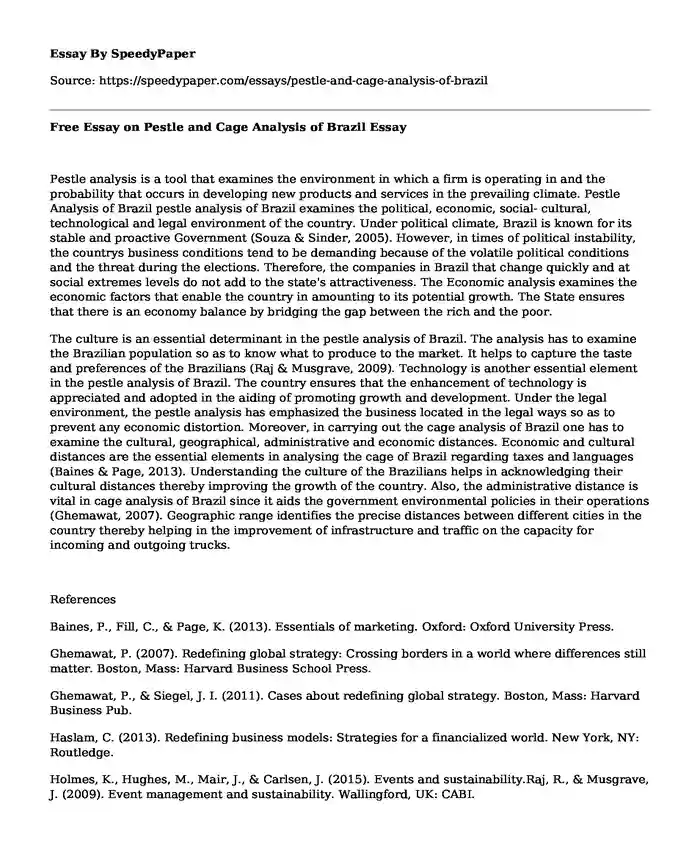Pestle analysis is a tool that examines the environment in which a firm is operating in and the probability that occurs in developing new products and services in the prevailing climate. Pestle Analysis of Brazil pestle analysis of Brazil examines the political, economic, social- cultural, technological and legal environment of the country. Under political climate, Brazil is known for its stable and proactive Government (Souza & Sinder, 2005). However, in times of political instability, the countrys business conditions tend to be demanding because of the volatile political conditions and the threat during the elections. Therefore, the companies in Brazil that change quickly and at social extremes levels do not add to the state's attractiveness. The Economic analysis examines the economic factors that enable the country in amounting to its potential growth. The State ensures that there is an economy balance by bridging the gap between the rich and the poor.
The culture is an essential determinant in the pestle analysis of Brazil. The analysis has to examine the Brazilian population so as to know what to produce to the market. It helps to capture the taste and preferences of the Brazilians (Raj & Musgrave, 2009). Technology is another essential element in the pestle analysis of Brazil. The country ensures that the enhancement of technology is appreciated and adopted in the aiding of promoting growth and development. Under the legal environment, the pestle analysis has emphasized the business located in the legal ways so as to prevent any economic distortion. Moreover, in carrying out the cage analysis of Brazil one has to examine the cultural, geographical, administrative and economic distances. Economic and cultural distances are the essential elements in analysing the cage of Brazil regarding taxes and languages (Baines & Page, 2013). Understanding the culture of the Brazilians helps in acknowledging their cultural distances thereby improving the growth of the country. Also, the administrative distance is vital in cage analysis of Brazil since it aids the government environmental policies in their operations (Ghemawat, 2007). Geographic range identifies the precise distances between different cities in the country thereby helping in the improvement of infrastructure and traffic on the capacity for incoming and outgoing trucks.
References
Baines, P., Fill, C., & Page, K. (2013). Essentials of marketing. Oxford: Oxford University Press.
Ghemawat, P. (2007). Redefining global strategy: Crossing borders in a world where differences still matter. Boston, Mass: Harvard Business School Press.
Ghemawat, P., & Siegel, J. I. (2011). Cases about redefining global strategy. Boston, Mass: Harvard Business Pub.
Haslam, C. (2013). Redefining business models: Strategies for a financialized world. New York, NY: Routledge.
Holmes, K., Hughes, M., Mair, J., & Carlsen, J. (2015). Events and sustainability.Raj, R., & Musgrave, J. (2009). Event management and sustainability. Wallingford, UK: CABI.
Richard, C., Jermyn, L., & Spilling, J.-A. (2012). Brazil. Tarrytown: Marshall Cavendish.
Souza, J., & Sinder, V. (2005). Imagining Brazil. Lanham, Md: Lexington Books.
Cite this page
Free Essay on Pestle and Cage Analysis of Brazil. (2019, Sep 24). Retrieved from https://speedypaper.com/essays/pestle-and-cage-analysis-of-brazil
Request Removal
If you are the original author of this essay and no longer wish to have it published on the SpeedyPaper website, please click below to request its removal:
- Free Essay on Billy Budd, Sailor by Herman Melville
- Free Essay on Change Management Strategies
- Free essay sample for students: Juan Mata's blog analysis
- Comparative Essay Sample: Stylet Angulation of 60 and 90 for the Ease of Intubation with Videolaryngoscope
- Business Plan for the Family Entertainment Center, Free Paper Example
- Essay Example about Romantic and Gothic Elements in Edgar Allan Poe's Poem
- Personal Statement for Nurse Practitioner Program
Popular categories





